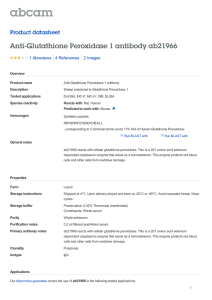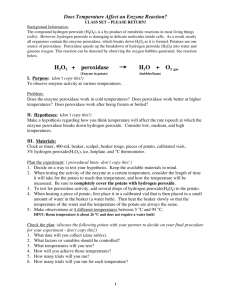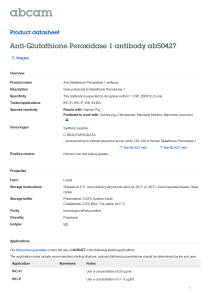AVOCADO INTERACTIONS AS EVIDENCED BY PEROXIDASE ACTIVITY AND STEM GROWTH
advertisement
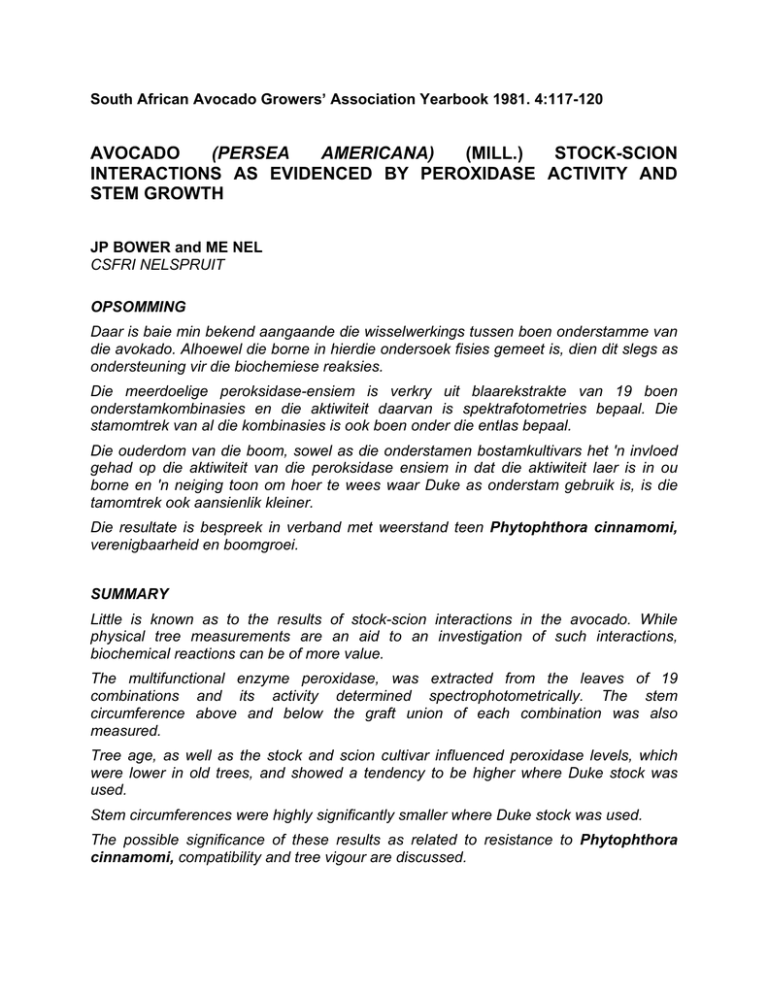
South African Avocado Growers’ Association Yearbook 1981. 4:117-120 AVOCADO (PERSEA AMERICANA) (MILL.) STOCK-SCION INTERACTIONS AS EVIDENCED BY PEROXIDASE ACTIVITY AND STEM GROWTH JP BOWER and ME NEL CSFRI NELSPRUIT OPSOMMING Daar is baie min bekend aangaande die wisselwerkings tussen boen onderstamme van die avokado. Alhoewel die borne in hierdie ondersoek fisies gemeet is, dien dit slegs as ondersteuning vir die biochemiese reaksies. Die meerdoelige peroksidase-ensiem is verkry uit blaarekstrakte van 19 boen onderstamkombinasies en die aktiwiteit daarvan is spektrafotometries bepaal. Die stamomtrek van al die kombinasies is ook boen onder die entlas bepaal. Die ouderdom van die boom, sowel as die onderstamen bostamkultivars het 'n invloed gehad op die aktiwiteit van die peroksidase ensiem in dat die aktiwiteit laer is in ou borne en 'n neiging toon om hoer te wees waar Duke as onderstam gebruik is, is die tamomtrek ook aansienlik kleiner. Die resultate is bespreek in verband met weerstand teen Phytophthora cinnamomi, verenigbaarheid en boomgroei. SUMMARY Little is known as to the results of stock-scion interactions in the avocado. While physical tree measurements are an aid to an investigation of such interactions, biochemical reactions can be of more value. The multifunctional enzyme peroxidase, was extracted from the leaves of 19 combinations and its activity determined spectrophotometrically. The stem circumference above and below the graft union of each combination was also measured. Tree age, as well as the stock and scion cultivar influenced peroxidase levels, which were lower in old trees, and showed a tendency to be higher where Duke stock was used. Stem circumferences were highly significantly smaller where Duke stock was used. The possible significance of these results as related to resistance to Phytophthora cinnamomi, compatibility and tree vigour are discussed. INTRODUCTION Rootstock-scion interactions are generally complex, and many tree characteristics, such as tree size, temperature tolerance, fruiting and disease resistance may be affected by the presence of a graft union and stock-scion interactions (Hartman and Kester, 1975). Little is known as to the characteristics or changes in characteristics of avocado cultivars, as a result of a different cultivar type as stock or scion (Ben-Ya’acov, 1972). However, some evidence exists to indicate an incompatibility reaction under certain circumstances (Pretorius, 1972), as well as there being the general observation that grafted trees are less vigorous than seedlings, and more susceptible to Phytophthora cinnamomi and other decline, thus having a shorter lifespan. Physical growth and performance of combination types can fairly easily, and indeed should be physically measured. Tubbs (1973) however, points out the need to examine biochemical factors in order to get closer to the basis of the interactions taking place. Peroxidase is a multifunctional enzyme, which has been linked by many authors to disease resistance and plant vigour (Cunningham, Liang, Moore and Heyne, 1975). It was thus considered a suitable enzyme with which to begin a biochemical study of stock-scion interactions. Leaf samples were considered to be suitable material with which to start. In addition, stem circumferences above and below the graft union were measured, so as to correlate growth characteristics with the biochemical results obtained. MATERIALS AND METHODS Nineteen combinations of stock and scion were examined. The majority were trees of 4 years old, while some 11 year old trees were available for testing the influence of tree age. The leaves used in the experiment were all healthy, fully mature, but not senescing. All the samples were also picked within a short period of time, and from approximately 1,5m above the ground, so as to make the samples as uniform as possible. This care was taken in an attempt to eliminate the possibility of enzyme changes with leaf age, as indicated by van Lelyveld and Bester (1978) and Braber (1979). The soluble proteins were then extracted following the acetone powder technique of van Lelyveld and Bester (1978). Ten grams of the leaf blades, excluding the midribs which were removed, were used per replication. Before extraction of the pigments in iced acetone, 10 per cent by mass carbowax 4 000 was added, to bind the phenols and remove possible inhibitors and activators (de Swart and Maxie, 1967; van Jaarsveld and Mynhardt, 1967 and van Lelyveld, Brodrick and Esterhuizen, 1975). The leaves were ground as fine as possible with an Ultra Turrax. The suspension was then filtered, and the precipitate, containing the proteins, washed with cold acetone. At this stage, the proteins were considered stable enough to be stored at —30°C, until they could be further processed. The proteins were dissolved in cold acetate buffer (approximately 2°C) pH as found suitable for the intended work, by van Lelyveld and Pretorius (1973), and filtered through fine muslin cloth. The resultant suspension was centrifuged in an MSE Prepspin 50 ultracentrifuge at 60 000 xg for 30 minutes at 2°C. The resultant supernatant was placed in cold acetone to precipitate the proteins and centrifuged at 12 000 xg for 30 minutes at 2°C. The supernatant was discarded, and the residue again suspended in acetate buffer and centrifuged as before at 65 000 xg. The supernatant was used for enzyme determinations. Peroxidase activity was immediately determined, using the technique of Ponting and Joslyn (1948) and van Lelyveld and Pretorius (1973), but deviating in equipment type and enzyme quantity. The incubating mixture consisted of 0,03 ml enzyme extract added to 20 ml pH 5 acetate buffer, 1 ml 0,05 M H2O2 and 1 ml 0,04 M guaiacol. The rate of change in absorbance at 420 nm as a result of guaiacol oxidation was immediately measured with a PYE Unicam SP8-200 UV/VIS spectrophotometer, set on range 4. The enzyme activity at 30°C was calculated in units 1-1, as internationally accepted (Berg Meyer, 1974; van Lelyveld and Bozalek, 1979). As an addition to the protein extraction, the stem circumferences above and below the graft union of the four year old trees were measured. RESULTS AND DISCUSSION Influence of tree age Three different combinations, but all on Duke stock, were available for tree age studies. The results are presented in Table 1. There would thus seem to be a substantial difference in peroxidase activity, decreasing with tree age. As the budwood used in the production of the new trees was cut from the old trees used in the experiment, it can be expected (Leopold and Kriedemann, 1975) that the juvenility factor as a result of the seedling stock used for the young trees, results in a change in the leaf peroxidase level. There is thus some indication that the stock is of some importance, influencing to some extent, the biochemical activity of the scion. Van Lelyveld and Broderick (1975) reported that leaf peroxidase activity decreased with increasing P. cinnamomi root-rot symptoms, and was lower in Fuerte as opposed to Duke leaves. This enzyme has also been associated with resistance to P. infestans in potatoes (Fehrmann and Dimond, 1967). All the trees in the experiment had been treated with "Ridomil", and had shown good growth and appeared healthy. It is thus unlikely that the presence of P. cinnamomi could be a significant factor. It is thus concluded, that tree age, and specifically that of the rootstock, is important in determining the peroxidase activity, and may help to explain why P. cinnamomi appears to take a greater toll in older orchards. The mode of action is not entirely clear, but it is suggested by the authors that lignifications may play a role. Neish (1965) postulates a role for this enzyme in lignin formation. It is thought that polymerisation may be mediated by peroxidase. A higher rate may enable the plant to protect itself against fungal attack more effectively, this ability decreasing as the plant ages. A seedling tree may survive longer than a grafted tree, in that there is a larger period of juvenility, whereas the older scion of a grafted tree could suppress the juvenile characteristics of the seedling, and thus lower the peroxidase levels in the plant, with resulting decreased ability to withstand P. cinnamomi attack. It has indeed been shown that lignification, correlated with higher peroxidase levels, does occur at pathogen entry sites (Vance and Sherwood 1976; Vance, Anderson and Sherwood, 1976). Stock-scion interactions The influence of the stock-scion interactions on leaf peroxidase activities and growth relationships is indicated in Table 2. There is a clear evidence in Table 2, that both the stock and scion play a role in the determination of leaf peroxidase levels. In general, the level of activity also appears to be higher where Duke stock was used. Should the theory of peroxidase activity as a pointer to P. cinnamomi resistance be correct, then the results obtained may assist in the best choice of stock for a particular scion. Of interest, is the fact that Fuerte on its own roots, indicated a higher peroxidase activity than when grafted onto either Duke or Zutano stocks. The mere presence of a graft union may thus inhibit the movement of substances within the tree as a whole, and thus influence the leaf peroxidase level. It should be asked at this stage, whether the presence of this evident stock-scion interaction on each other's biochemistry, may lead to, in some cases, incompatibility, especially considering the role of peroxidase in lignin formation which Buchloh (1960) indicated to be disturbed in poor graft unions. In addition Seguiera and Mineo (1966) and Copes (1968) found that peroxidase enzymes could affect auxin (IAA) levels. Leopold and Kriedemann (1975) report the effect of IAA on growth and Fan and McLachlan (1966) the effect on cell walls and constituents. This means that differences in growth should be evident in different combinations. Inherent differences in peroxidase levels may therefore be expected to cause an imbalance in stock-scion growth, generally believed to be a symptom of incompatibility (Tubbs, 1973). A scion-stock ratio of one would therefore presumably be most desirable. It is not known to what extent a deviation from one can be accepted as permissible, but an indication of which combinations are likely to be better, can be gained, as indicated by Table 2. The level of leaf peroxidase activity alone, does not assist in this regard. However, of importance, is the finding that, over the whole orchard, a highly significant stock-scion relationship was found. This is shown in Table 3. The interaction scion on Duke stock x scion on Zutano stock = t (68)= 2,798** The interaction stock Duke x stock Zutano = t (68) = 2,779** It would thus seem that generally, the Duke stock, due to an inherently higher peroxidase level than Zutano, and thus a higher rate of IAA destruction has a highly significantly lower growth rate. Shanan (1976) did in fact correlate high levels of peroxidase activity with dwarfing in beans. This appears in the case of the avocado, to be passed onto the scion, and evidently relatively strongly, judging by the scion on Duke x scion on Zutano interaction, and the stock-scion ratios. CONCLUSIONS Both leaf peroxidase activity levels and tree stem growth, indicate clear stock-scion interactions. While each part of the composite plant retains its original characteristics, the final resulting biochemical activity and growth, are due to a complex set of interactions, probably hormonal (Tubbs, 1973). The trends exhibited by peroxidase in the avocado, together with this enzyme's known and postulated modes of action, may help to explain at least some aspects of the phenomena seen in avocado orchards, including the changing susceptibility to P. cinnamomi with age, the existence of a scion, as opposed to a seedling or ungrafted plant, and apparent dwarfing characteristics of Duke as opposed to Zutano as rootstock. The investigation of other enzyme activities as well as peroxidase in other plant parts, especially the roots and bark above and below the graft union should assist in forecasting the result of a particular combination. LITERATURE CITED BEN-YA'ACOV, A., 1972. Avocado rootstock-scion relationships: A long term large scale field research project. Cal. Avo. Soc. Yrbk. 55: 158 - 161. BERGMEYER, HU, 1974. Methods of enzymatic analysis. Verlag Chemie: Weinheim. BRABER, J.M., 1980. Catalase and peroxidase in primary bean leaves during development and senescence. Z. Planzenphysiol. 97: 135 - 144. BUCHLOH, G., 1960. The lignification in stock-scion junctions and its relation to compatibility. Phenolics in plants-in health and disease. Ed: PRIDHAM, J.B. Pergamon Press: Long Island City. CUNNINGHAM, B.A., LANG, G.H., MOORE, R.M. & HEYNE, E.G., 1975. Peroxidase activity in near isogenic height lines of Triticale. J. Hered. 66: 151 - 154. DE SWART, G.H. & MAXIE, E.C., 1976. Pectin methyl esterase in the ripening banana. S.A.J. agric. Sci. 10: 501 - 506. FAN, D.F. & McLACHLAN, G.A., 1966. Control of cellulase activity by indoleacetic acid. Can. J. Bot. 44: 1025 - 1034. FEHRMANN, H. & DIMOND, A.E., 1967. Peroxidase activity and Phytophthora resistance in different organs of the potato plant. Phytopathology 57: 69 - 72. HARTMAN, H.T. & KESTER, D.E., 1975. Plant propagation. Principles and practices. Prentice-Hall: Englewood Cliffs. LEOPOLD, A.C. & KRIEDEMANN, P.E., 1975. Plant growth and development. McGraw-Hill: New York. NEISH, A.C., 1965. Coumarins, Phenylpropanes and lignin. in: Plant Biochemistry. Ed: BONNER, J. & VARNER, J.E. Academic Press: New York. PONTING, J.D. & JOSLYN, M.A., 1948. Ascorbic acid oxidation and browning in apple tissue extracts. Arch. Biochem. 19: 47 - 63. PRETORIUS, W.J., 1972. A symptom of graft incompatibility associated with declining avocado trees. Agroplantae 4: 19 - 22. SEGUIERA, L. & MINEO, L., 1966. Partial purification and kinetics of indoleacetic acid oxidase from tobacco roots. PI. Physiol. 41: 1200 - 1208. SHANAN, S.A., 1976. The effect of gibberellic acid on lignification and peroxidase activity in dwarf bean. Scient. Hort. 5: 297 - 302. TUBBS, F.R., 1973. Research fields in the interaction of rootstocks and scions in woody perenials — Part 2. Hort. Abst. 43(6): 325 - 335. VANCE, C.P. & SHERWOOD, R.T., 1976. Regulation of lignin formation in Reed Canary grass in relation to disease resistance. PI. Physiol. 57: 915 - 919. VANCE, C.P., ANDERSON, J.O. & SHERWOOD, R.T., 1976. Soluble and cell wall peroxidase in Reed Canary grass in relation to disease resistance and localized lignin formation. PI. Physiol. 57: 920 - 922. VAN JAARSELD, P.P. & MYNHARDT, J.T., 1967.The effect of carbowax on the activity of indoleacetic acid oxidase from peach leaf tissue. S.A.J. agric. Sci. 10: 901 - 908. VAN LELYVELD, L.J. & BESTER, A.I.J.. 1978. A Phytophthora induced inhibitor of peroxidase activity in avocado leaves. Phytopath. Z. 93: 69 - 79. VAN LELYVELD, L.J. & BOZALEK, S.J., 1979. Reliability of the acetone powder enzyme extraction method for peroxidase activity determination in pineapple leaves and roots. Agrochemophysica 11: 5 - 6. VAN LELYVELD, L.J. & BRODRICK, H.J., 1975. Enzymatic responses of avocado leaves to Phytophthora root rot. Agroplantae 7: 13 - 16. VAN LELYVELD, L.J., BRODRICK, H.K. & ESTERHUIZEN, E.W., 1975. The effect of carbowax 4000 on the activity of peroxidase and Polyphenol oxidase enzyme extracts from citrus leaves. Agroplantae 7: 75—85. VAN LELYVELD, L.J. & PRETORIUS, W.J., 1973. Assay methods for determining enzymatic activity of a-amylase, indole-3acetic acid oxidase, Polyphenol oxidase, peroxidase and ascorbic acid oxidase in a crude extract from avocado tree bark. Agrochemophysica 5: 29 - 34.
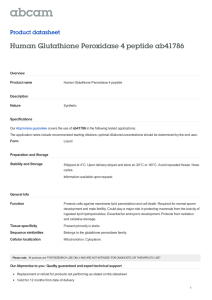
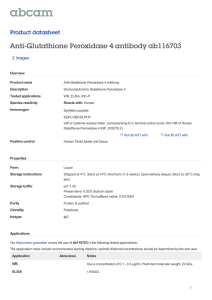
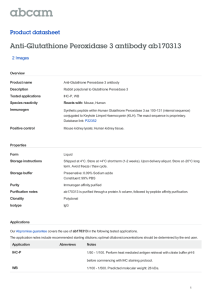
![Anti-Thyroid Peroxidase antibody [1.B.10] ab31829 Product datasheet Overview Product name](http://s2.studylib.net/store/data/011964745_1-5f75fbef9c57765583cc9a2be1b15b4b-300x300.png)

